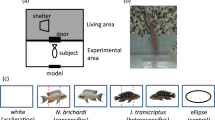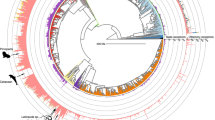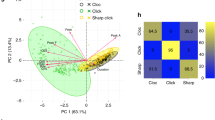Waiting alligators can detect silent ripples in the water even in total darkness.
Abstract
Crocodilians hunt at night, waiting half-submerged for land-bound prey to disturb the water surface. Here I show that crocodilians have specialized sensory organs on their faces that can detect small disruptions in the surface of the surrounding water, and which are linked to a dedicated, hypertrophied nerve system. Such 'dome' pressure receptors are also evident in fossils from the Jurassic period, indicating that these semi-aquatic predators solved the problem of combining armour with tactile sensitivity many millions of years ago.
This is a preview of subscription content, access via your institution
Access options
Subscribe to this journal
Receive 51 print issues and online access
$199.00 per year
only $3.90 per issue
Buy this article
- Purchase on Springer Link
- Instant access to full article PDF
Prices may be subject to local taxes which are calculated during checkout


A. BRITTON
Similar content being viewed by others
References
von During, M. Z. Entwicklungsgesch. 143, 81–94 (1973).
Jackson, K., Butler, D. G. & Youson, J. J. Morphol. 229, 315–324 (1996).
Gregory, J. E., Iggo, A., McIntyre, A. K. & Proske, U. Nature 326, 386–387 (1987).
Molenaar, G. J. Brain Res. 78, 340–344 (1974).
Benton, M. J. & Clark, J. M. in The Phylogeny and Classification of the Tetrapods (ed. Benton, M. J.) 295–338 (Clarendon, Oxford, 1988).
Clark, J. M. in In the Shadow of the Dinosaurs: Early Mesozoic Tetrapods (eds Fraser, N. & Sues, H.-D.) 84–97 (Cambridge Univ. Press, 1994).
Author information
Authors and Affiliations
Corresponding author
Ethics declarations
Competing interests
The author declares no competing financial interests.
Rights and permissions
About this article
Cite this article
Soares, D. An ancient sensory organ in crocodilians. Nature 417, 241–242 (2002). https://doi.org/10.1038/417241a
Issue Date:
DOI: https://doi.org/10.1038/417241a
This article is cited by
-
The rise of macropredatory pliosaurids near the Early-Middle Jurassic transition
Scientific Reports (2023)
-
A rostral neurovascular system in the mosasaur Taniwhasaurus antarcticus
The Science of Nature (2020)
-
Hydrodynamic reception in the Australian water rat, Hydromys chrysogaster
Journal of Comparative Physiology A (2020)
Comments
By submitting a comment you agree to abide by our Terms and Community Guidelines. If you find something abusive or that does not comply with our terms or guidelines please flag it as inappropriate.



